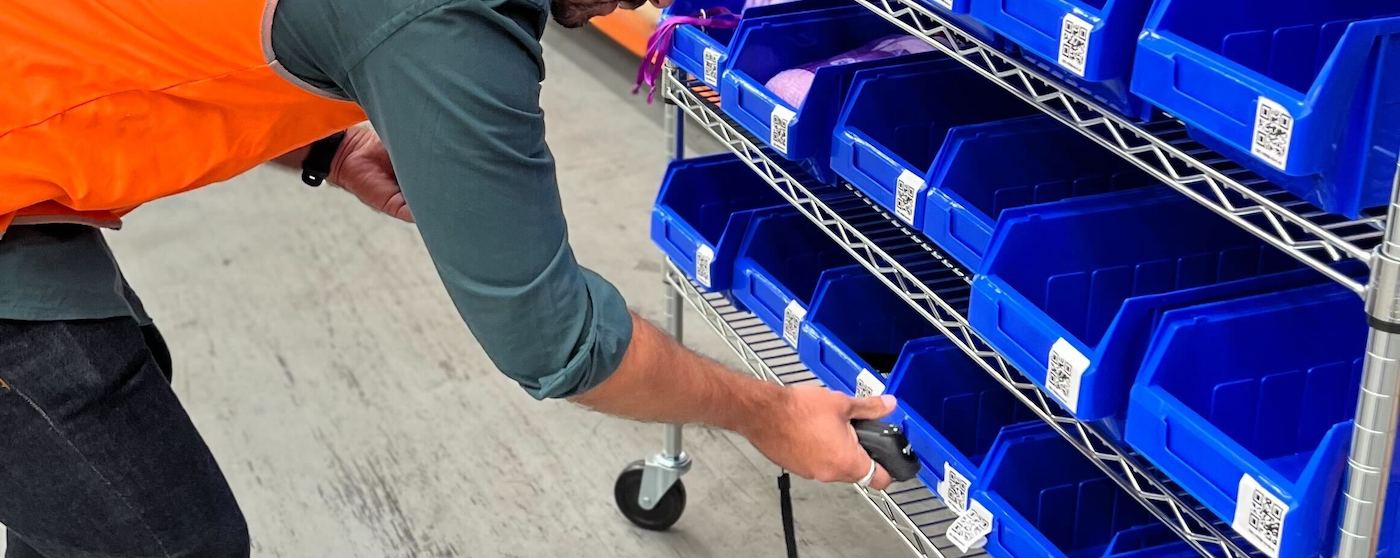Imagine you have a bunch of small items in your warehouse and small orders to pick regularly. Using the pick-to-cart process is a productive way to fulfil multiple orders at once.
“Pick to cart” is a common batch picking method for busy warehouses. And thanks to today’s warehousing technology, the method has been greatly approved upon.
How does it work exactly? In this article, we offer a comprehensive guide to this warehouse picking process.
What is pick to cart?
By implementing a pick-to-cart model, warehouse operators lead a cart to pick SKUs from one location, place the SKUs in multiple containers on a cart, and move to the next pick location, led by the radio frequency (RF) network.
Pick to cart has for the longest time been a traditional batch picking model, but the newer models use bar codes and automation.
There is also more technologically advanced pick to cart variants like pick to light and voice picking.
Pick to light
For greater speed and picking accuracy, you could choose the pick to light system.
Coloured LED lights, placed across the warehouse, are used in tandem with a series of letters and numbers to aid in the picking, putting, sorting, and assembling of products.
Voice picking
Both paperless and handsfree, this system improves efficiency.
With voice picking, operators wearing headsets are directed through the ideal pick paths via voice prompts.
Pick to cart vs. batch picking vs. zone picking
| Pick to cart | Batch picking | Zone picking |
| Pick to cart involves manually picking SKUs and placing them into a cart (equipped with plastic crates and manned by an operator) for order fulfilment. | Batch picking involves picking multiple units of the same product, in one go, for different orders. | Zone picking involves splitting warehouses into sections that order pickers are assigned to. |
| One picker picks items for many orders in one go. | One picker picks items for many orders in one go. | One order is divided amongst many pickers, who are assigned to different zones. |
| Pick to cart is a type of batch picking. | Traditional batch picking, pick to cart, and pick to box are variants of batch picking. | N/A |
| Best used when there is a high concentration of SKUs stored, SKUs are small, or SKUs are limited in number. | Best used when you receive many single-SKU orders or when your SKUs are easy to handle and similar in size. | Best used when you have high stock keeping unit (SKU) counts and face a variety of order types. |
How does the pick to cart system work?
This batch-picking model involves an operator manning a mobile picking vehicle with enough surface area to accommodate many orders.
When pick to cart and packing are combined, the time-consuming consolidation step is eliminated, and the process is called pick and pack to cart.
Here, items are picked from a warehouse location and packed for shipping.
Order is placed and processed
Once the order is placed, it is sent to your warehouse management system (WMS). And automatically picking tasks are created.
Cart and operator are prepped
The cart barcode is recorded with the scanner. An operator is assigned to a cart and they are shown the most optimised pick route.
This order picking cart is driven from one storage location to another, guided by the display, voice, or lights.
Item is picked
The cart operator is directed to the first item that needs to be scanned with a barcode scanner to fulfil the order.
Item is verified
Once the correct units of the item are picked, your display will indicate where in the cart the item should be placed. Then, the display asks to scan the second product.
Cart is returned
Once all the items from an order are picked, the cart is returned and the SKUs consolidation happens.
Order is packaged and shipped
Once consolidated the order is put into cartons or packaged based on need and shipped to the end-customer.
Inventory is updated
Once the order is picked and shipped, the inventory count is updated in the WMS and the storefront.
Advantages of pick to cart
There are several reasons why the pick-to-cart model is common across warehouses. Here is an overview of the advantages of pick to cart.
Reduce order fulfilment time
Since the orders are picked in batches, you do away with time-consuming fulfilment steps.
These batches are created based on priority, order size, or order cut-off time to increase productivity.
Since many orders can be picked in one batch, pick to cart reduces walking distance and time. If you use the pick to pack process, you also eliminate the time-consuming consolidation battle after batch picking.
This, in turn, reduces fulfilment times and improves On-Time In-Full (OTIF).
Can be used with other picking methods
You can implement the pick-to-cart process along with other order picking processes, such as zone picking and wave picking.
Technology can be used in conjunction with pick to cart
RFID tags, WMS, put to light, tablets, printers, and speakers can be used to improve the efficiency of the pick to cart process.
The lowest capital costs, but the highest operating costs.
Though there isn’t too much upfront investment, a lot more costs are incurred by retailers in terms of training and implementation.
Challenges and drawbacks of pick-to-cart methods
Here are some of the challenges businesses face with pick to cart.
Potential traffic in warehouse aisles
When many orders need to be picked by multiple carts, the warehouse pathways can get clogged with traffic.
Carts are cumbersome
Warehouse picking carts are bulky and take up too much space. They need three to four feet of aisle width. And you need special training to learn to drive these carts.
Potential for human error
Many times, because of the sheer variety of items to pick from, there can be errors in the order picking.
This is why it’s important to be guiding associates through the warehouse. Also, your operator may place the picked item in the wrong container.
Types of carts used with the pick to cart model
Types of carts commonly used with the pick-to-cart system in warehousing or order fulfilment operations are:
Stock picking carts
This slim-framed cart comes with an integrated step ladder for access to SKUs placed at higher levels.
Being of a solid steel build, this is one of the preferred options for picking heavy-duty or heavy loads or high-capacity picking.
Bin carts
Bin carts is a small container option for medium- and small-size items, ranging from spare parts to electrical equipment.
This configurable picking trolley is great for organising the many items of orders into different slots.
Mobile racking carts
Mounted on ergonomic mobile trolleys, mobile racking carts are entire racks that are moved (noiselessly) by electronic or manual control. This cart improves storage space for a small carbon footprint.
Roll containers
Roll containers are made of metal and have mesh walls and horizontal shelves. This makes it possible to safely transport larger quantities of items.
For special items
Depending on the goods being picked, you can find carts customised to different needs. For example, for picking clothes your cart will have bars with hangers.
Is pick to cart right for your business?
Does your business have a lot of slow- and medium-moving items and low- to medium-volume orders? Then, pick to cart is likely to work for you.
You might want to choose the pick-to-cart method if:
- The concentration of SKUs in the warehouse is high and the orders are low.
- SKUs in your warehouse are small in size and easy to transport.
- Most orders have common SKUs. So, the operator can go to a few locations and pick all items in the orders, improving the pick rate.
- Only a few SKUs are stored in the warehouse, so the complexity of sorting is lower.
When is it NOT the best option?
If your business has orders with large volumes or are bulky in nature, it’s best to avoid the pick to cart system.
Here are scenarios in which pick to cart would not be the best option.
- When you have a high volume of orders, it can significantly increase the traffic within the warehouse delaying order picking.
- If your SKUs need to travel big distances within the warehouse, it’s not helpful to use pick to cart, instead choose zone picking for greater speed.
- If your SKUs are bulky or difficult to handle then pick to cart will not be enough.
The role of WMS in pick to cart operations
A robust warehouse management system (WMS) can optimise your pick to cart operations.
For one, it creates the best picking routes for each batch of orders. It also consistently improves the picking process based on inputs from identification devices that are on the ground.
For example, ShipBob’s WMS helps in the planning and maintaining of accuracy during the pick-to-cart operations and monitoring the efficiency of your pick-to-cart process.
Why ShipBob’s WMS solution is a top-tier choice for your warehouse operations
In an ultra-competitive retail environment, businesses can’t afford to exclude WMS technology from their logistics operations.
Smart warehousing is a standard now for operating a growing ecommerce business. That’s why ShipBob offers a WMS solution that helps to improve warehouse management.
Whether you choose to completely outsource fulfilment to ShipBob or implement ShipBob’s WMS in house, ShipBob’s WMS improves accuracy, speeds up fulfilment, and provides extensive real-time data.
“ShipBob’s WMS is intuitive and easy to use with great reporting. Being able to track real-time metrics at the person-by-person level is awesome. We told our team that we wouldn’t be tracking their fulfilment metrics everyday, but having the functionality to see how people are doing is helpful for forecasting and also to reference if we have to say, ‘Last month you were here and everyone else was here, where is there a disconnect?’
We have been able to set some standard practices of what’s fulfilable and what can be done in a day. In our old system, we knew we had a certain amount of orders to get to in a day, but we didn’t know which ones to prioritise.
Our managers had to manually go in and see which orders took priority. Using ShipBob’s WMS has cleared up a lot of time for our managers because now they don’t have to dictate which orders need to be fulfiled first, the system does that for us.”
Clint Sanders, VP of Operations of Bunker Branding
Pick to cart FAQs
Below are answers to the most common questions about pick to cart.
Who can benefit most from implementing a pick to cart system?
Pick to cart is most beneficial for ecommerce businesses who have smaller SKUs, a high concentration of SKUs in the warehouse, and a low count of orders.
What is pick to cart and how does it differ from other picking methods?
Pick to cart involves having an operator use a cart to pick SKUs for multiple orders in one go. It is different from zone picking since all items are picked by one operator. Also pick to cart is better for single-SKU orders or when your SKUs are easy to handle and similar in size.
Can multiple orders be picked simultaneously using a single cart?
Yes, with pick to cart, many different orders can be picked at the same time with a single cart and then consolidated before shipping.
Can the pick to cart process be combined with other picking methods, such as batch picking or zone picking?
Yes, pick to cart (a batch picking process) can be combined with zone picking and wave picking.
Can the pick to cart process be used for both single-item orders and multi-item orders?
Single- and multi-order picking can be picked with pick to cart. In one go, all the SKUs for the order are picked. And at the end of the picking process, with sortation processes, the SKUs are segregated and consolidated.
Are there any specific software or technology integrations required for implementing the pick to cart process?
Warehouse management system have the functionality to improve overall warehouse operations, including inventory tracking, picking processes, and fulfilment speed.
Can the pick-to-cart process be adapted for seasonal or peak demand periods?
For high demand or order periods, the pick-to-cart process can be modified to include a conveyor system for easy movement of the boxes.



